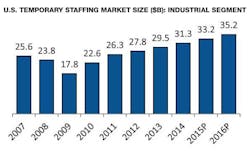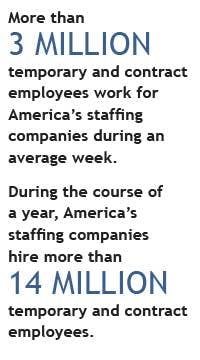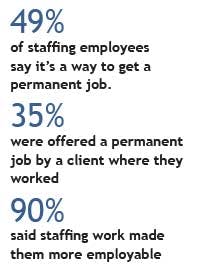In the southeastern United States, the only thing rarer than an autumn without super-storms is a certified forklift driver who likes to move from job to job, make less than a permanent employee and not have company-provided health benefits.
"A customer will call and say, 'Well, gosh, we'd like to have a forklift driver. We'd like them to start as a temporary and then take them permanent,'" says Abigail Tremble, executive vice president of national operations at Atlanta-based Randstad, the world's second-largest staffing services agency. "And we have to say, 'You know what, we would love to help you, but at this point we're only accepting those positions as direct hire positions.'"
Randstad has seen a surge in demand for temporary workers in manufacturing fields, and it's part of a trend across what's known as the staffing services sector. While the number of manufacturing workers in the United States declined dramatically in the past two decades, the number of temporary workers in manufacturing has substantially increased. In 1990, 42% of the U.S. temporary workforce consisted of clerical workers, while 28% was manufacturing and industrial, according to a 2012 study from the Bureau of Labor Statistics, Manufacturers' Outsourcing to Staffing Services.
By 2000, those percentages had flipped, with 47% of the temp workforce consisting of manufacturing and industrial workers -- a trend that has remained consistent. And the size of the temporary workforce is increasing. In 2010, as economic recovery began, the temporary workforce overall grew by 9%. Staffing Industry Analysts, an industry accrediting organization, sees the demand for temporary labor in the industrial sector increasing by 6% in 2015.
As the temporary workforce grows, so do the problems with temporary labor, as incidents crop up of temporary workers being subject to discriminatory treatment, shorted pay, or at the mercy of just-in-time scheduling that requires them to plan their days around work that could be canceled minutes before they show up.
After a worker was killed in a conveyor belt accident at an Amazon warehouse in 2014, an OSHA investigation found that four different temp agencies were overseeing warehouse workers, and yet another temporary agency was overseeing the other agencies. All five agencies were cited.
In 2009, the Equal Employment Opportunity Commission ruled that Pittsburgh Plastics Manufacturing subjected female temporary workers to "egregious sexual harassment and fired an employee who opposed the harassment," and then ignored the women's complaints to both the company and the temporary agency, Addeco. The women filed a lawsuit, which was settled out of court.
Part of the increase in temporary manufacturing labor stems from companies not being ready to commit to full-time labor and wanting to "augment their needs" as the economy bounces back, says Gabrielle Caputo, who oversees the manufacturing and logistics business for staffing agency Kelly Services.
The demand for manufacturing workers "has increased pretty dramatically across the staffing industry," adds Tremble. "When we look at our growth overall as an organization, and then when we look at the demand, the orders that are coming in, it is very clear that we are experiencing a manufacturing boom."
Significantly, the U.S. Department of Labor counts these workers as temporary labor, not manufacturing labor, in its official numbers. (More on the numbers)
"Several years ago, the mantra was manufacturing is going to all be outsourced, and the U.S. will be more of a service environment, knowledge environment," says Becca Dernberg, vice president of the Northeast Divison of Manpower, Inc. "But manufacturing has come back very robustly. It looks different. It's not your grandfather's manufacturing."
Randstad has particularly seen an increase in apprentice-type positions like welders, CNC machine operators and the aforementioned forklift drivers. "But we also see, just simply based on the boom in the industry, that the unskilled workers are also in high demand," says Tremble.
To meet demand, the company recently upped the ante from a twice-yearly recruiting expo "to a monthly routine where we're doing a full-throttle effort on recruiting for those skilled and supervisory positions," says Tremble. For the high-demand positions, "you're having to recruit individuals who are currently working who are not active jobseekers."
Temporary workers in the manufacturing sector also typically need more training than in the past, whether it's training on company requirements, welding, forklift driving or SAP, says Dernberger. This requires more of an investment of a company's time and money.
"The way companies use us is really different than, 'We just need somebody to come pack a box.' We get some of that, but it's less and less. General is becoming more and more non-existent. When the majority of our companies need individuals, there is some technical component to the job."
Compliance Challenge
The contingent workforce -- which includes temps and contract workers -- is sorely lacking in oversight, says Robert Strassfeld, a professor of labor law at Case Western Reserve University. Employment law is murky on temporary employees and when violations do attract regulators' attention, they tend to be egregious.
"For a long time now, the wage and hour division of the Labor Department and OSHA have been severely understaffed," says Strassfeld. "To some extent, these agencies are doing the best they can, but they're constantly falling behind. And part of what triggers the attention they will pay is if something goes horribly wrong, or if there's somebody at a particular workplace yelling and screaming about what is going on."
Federal sentencing guidelines that govern corporate ethics and compliance don't exempt temporary employees, says Andy Foose, a former federal civil rights attorney who is now vice president of Advisory Services at ethics and compliance software company NAVEX. Instead, they fall under guidelines for permanent employees. Taking that into consideration, Foose sees three additional risk areas for a company that uses temporary employees, compared to a company that doesn't.
"One, is that temporary workers are not being trained on topics that carry real legal and reputational risks to the company," like safety and wage rules, says Foose. "Two, is that temporary workers don't feel comfortable or know how to speak up, if they're aware of a potential legal or policy violation. And third, if temporary workers are hired through an agency or as independent contractors, there's a risk of violating Department of Labor regulations if their engagement is extended over time."
That third risk is especially pertinent for manufacturers, who are increasingly hiring temporary workers for skilled positions. Custodial staff or security people "can work forever," says Foose. "The Department of Labor is not going to say those people are doing work that is core to the business of that company. Those are peripheral services. But in a manufacturing setting, if you had a temporary worker doing the same welding work or chemical work as another employee, it ought to be for a limited duration."
While there is no legal limit for how long someone can work for a particular employer as a temp, if a case attracts the Department of Labor's attention, whether through a lawsuit or a complaint from an unhappy employee, investigators will likely parse the details of the temporary worker's employment to determine whether they've been miscategorized.
"Factors that will go into the equation will not only be how long that person's in there, but are they doing the exact same job as some other full-time employees are," says Foose. "If it's a special job, it's one thing, but if it's part of the core business that the company's doing, then it makes them look more like a full-time employee."
Several years ago, the mantra was manufacturing is going to all be outsourced, and the U.S. will be more of a service environment, knowledge environment. But manufacturing has come back very robustly. It looks different. It's not your grandfather's manufacturing.— Becca Dernberg, vice president, Northeast Division of Manpower, Inc.
In addition, while manufacturers might want to boost workplace morale by encouraging temporary workers to share ideas or attend quarterly meetings, too much blurring of roles can stir up trouble. "The more things that a company does to treat the temporary worker the same as the full-time employee, the more that the Department of Labor is going to consider them a full-time employee," says Foose. Things like, "Do they all have the same access to the gym? Do they all get invited to the same Fourth of July picnic? Does the temporary worker take the annual employee survey?"
Foose says a good guideline is that if a meeting or company function isn't related to a temporary worker's job, that worker shouldn't be included.
The U.S. Department of Labor's view, says Foose, is that if "someone comes on as a temporary worker, they ought to be temporary. If they come on as an independent contractor, they should be there for the duration of a specific project. But if those roles get rolled over, over time -- because the temporary need continues on into the future, or the independent contractor does such a great job they keep them around doing other tasks -- the Department of Labor might determine that person really ought to be a full-time employee and therefore really ought to be receiving benefits, and the employer should be paying their employment taxes."
A 'Flexible Workforce' Alternative
Klein Steel Services in Rochester, N.Y., is a custom steel company that employs 200 people, "or 199, or 201, depending on which day you ask," jokes Patrick DiLaura, Klein's chief talent officer. Because workers are operating very specialized equipment -- many of the jobs on the plant floor are complex and require a high skill level. For that reason, Klein primarily uses temporary workers in its warehouse in jobs "that don't require as intricate a skill level," including material handling, order placing/packing, and grinding.
To stay competitive, Klein requires a flexible workforce to handle increases in demand, new product lines or seasonal changes. But "the way we create a flexible workforce is to ensure that we're crosstraining our skilled positions," says DiLaura. "That's how we create the depth.
"So if we have people missing from work for whatever reason, or if we need to expand our capacity for short-term project-type work, we'll do that with our existing team members who have already been trained and certified on different equipment and who understand our safety standards, who understand our culture, our values."
Often, temporary workers just haven't been cost-effective. "In our experience, by the time you have trained someone to do the job, either the need has already passed, or sometimes the temporary employee will find permanent employment elsewhere," says DiLaura. "If it's a more involved role, it's hard to get that return on your investment of time and money."
When they do use a temporary agency, they evaluate the agency thoroughly, both by sizing up the quality of candidates they're sending and spending time with the agency onboarding them "and helping them understand what our culture is and our expectations are, much as we would do with an applicant. That way, when they go to source candidates for us for temporary positions, they have a pretty clear picture of what our expectations are. We like doing business with companies that share our values and our vision of how we like to treat people."
Temporary employees are viewed as potential permanent employees. "Most often, temp to perm is how we're using them," says DiLaura. "We've had some success with it -- but not as much as we have with our own direct hires."







